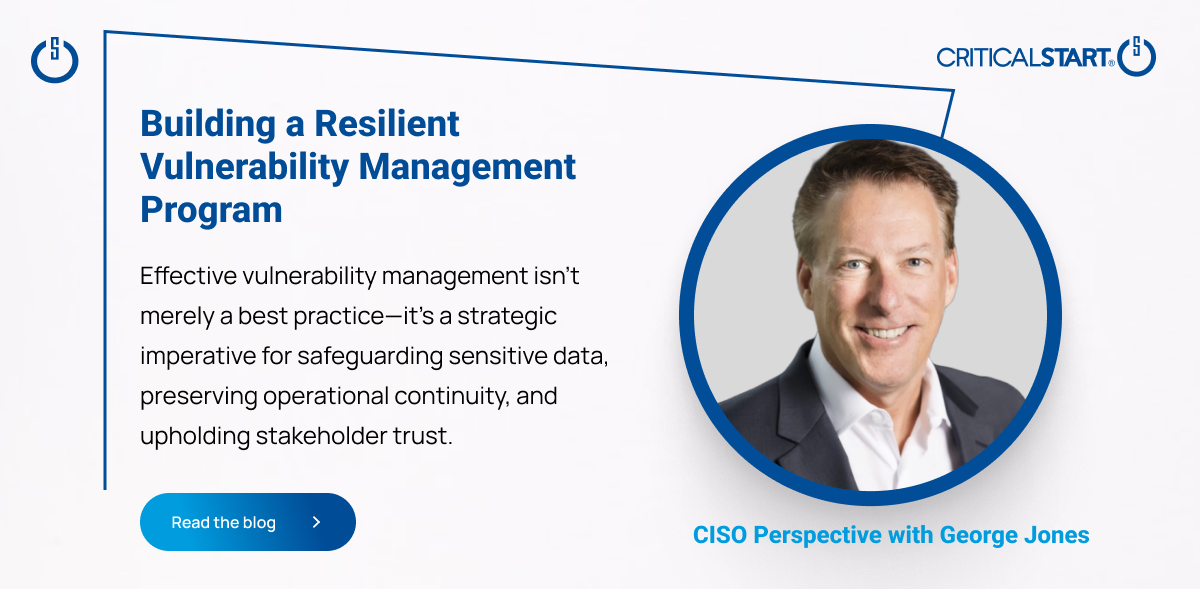CISO Perspective with George Jones: Building a Resilient Vulnerability Management Program

In the evolving landscape of cybersecurity, the significance of vulnerability management cannot be overstated. Cyber threats are dynamic and relentless, constantly evolving in sophistication and scope. From novel malware strains to intricate social engineering tactics, adversaries continually seek to exploit weaknesses in systems and networks. In this context, the need for organizations to adapt and fortify their defenses is paramount.
Today’s cyber threats transcend traditional boundaries, infiltrating networks through various entry points and exploiting vulnerabilities across diverse platforms and devices. As such, effective vulnerability management isn’t merely a best practice—it’s a strategic imperative for safeguarding sensitive data, preserving operational continuity, and upholding stakeholder trust.
At its core, vulnerability management encompasses the processes and practices aimed at identifying, assessing, prioritizing, and mitigating security vulnerabilities within an organization’s IT infrastructure.
In the following discussion, we’ll delve into the challenges faced by cybersecurity professionals in building resilient vulnerability management programs and explore actionable strategies to navigate these complexities effectively.
Challenge: Volume and Diversity of Vulnerabilities
One of the most daunting challenges in vulnerability management is the sheer volume and diversity of vulnerabilities discovered on a regular basis. Vulnerabilities range from software bugs and coding errors to misconfigurations and design flaws, spanning across a multitude of applications, systems, and devices.
The relentless pace of technological innovation, coupled with the increasing complexity of IT environments, exacerbates this challenge. As new software versions are released, patches issued, and configurations updated, the attack surface expands, leaving organizations vulnerable to exploitation.
Keeping pace with the rapid influx of vulnerabilities requires cybersecurity professionals to adopt a proactive and systematic approach. However, the manual effort required to identify, assess, and prioritize vulnerabilities can quickly become overwhelming, particularly for organizations with limited resources and manpower.
Moreover, the diversity of vulnerabilities introduces another layer of complexity. Each vulnerability may possess unique characteristics, including its severity, exploitability, and potential impact on business operations. Effectively triaging and prioritizing these vulnerabilities becomes a Herculean task, further straining cybersecurity teams already stretched thin.
Challenge: Resource Constraints
A common hurdle faced by organizations in vulnerability management is the constraint of limited resources, encompassing time, budget, and skilled personnel. These constraints pose significant obstacles to the effective identification, assessment, and remediation of vulnerabilities, thereby amplifying the organization’s exposure to cyber threats.
- Time Constraints: Time is often a scarce commodity in cybersecurity operations. With an ever-growing list of tasks and responsibilities, cybersecurity teams find themselves grappling with competing priorities. As a result, critical vulnerability management activities, such as regular scanning and patching, may take a back seat to more immediate concerns, leaving systems vulnerable to exploitation.
- Budgetary Limitations: Adequate funding is essential for investing in the necessary tools, technologies, and resources to support robust vulnerability management practices. However, budgetary constraints frequently force organizations to make tough decisions about where to allocate limited funds. As a result, cybersecurity initiatives may receive inadequate funding, hampering efforts to implement comprehensive vulnerability management strategies.
- Skilled Personnel Shortages: The cybersecurity talent gap is a well-documented challenge, with organizations struggling to recruit and retain skilled professionals capable of effectively managing vulnerabilities. The shortage of qualified personnel can hinder vulnerability detection, analysis, and remediation efforts, leading to delayed response times and increased exposure to cyber threats.
These resource constraints collectively impede the organization’s ability to proactively identify and address vulnerabilities in a timely and effective manner. Without sufficient time, budget, and skilled personnel, vulnerability management efforts may become reactive rather than proactive, leaving the organization vulnerable to exploitation.
To mitigate the impact of resource constraints on vulnerability management, organizations must prioritize resource allocation based on risk and impact. This may involve leveraging automation tools to streamline repetitive tasks, optimizing existing processes to maximize efficiency, and investing in training and development programs to upskill existing personnel.
- Importance of Proactive Strategies and Resource Optimization
To address these challenges, organizations must adopt proactive strategies and leverage available resources efficiently:
Prioritization: Implement risk-based prioritization frameworks to focus efforts on vulnerabilities with the highest potential impact, ensuring optimal resource allocation.
Automation: Utilize automation tools and technologies to streamline vulnerability detection, assessment, and remediation processes, maximizing efficiency and reducing manual workload.
Collaboration: Foster collaboration between IT, security teams, and other stakeholders to enhance visibility, coordination, and communication in vulnerability management efforts.
Continuous Improvement: Embrace a culture of continuous improvement and adaptation, regularly reviewing and updating vulnerability management practices to reflect evolving threats and organizational changes.
Encouraging Ongoing Adaptation and Improvement
In the face of evolving cyber threats, ongoing adaptation and improvement are essential:
- Education and Training: Invest in training and development programs to enhance the skills and expertise of cybersecurity professionals involved in vulnerability management, keeping them abreast of the latest threats and best practices.
- Continuous Monitoring: Implement continuous monitoring and assessment practices to detect emerging threats and vulnerabilities in real time, enabling proactive response and mitigation.
- Feedback and Review: Solicit feedback from key stakeholders to identify areas for improvement and implement corrective actions, ensuring the effectiveness and relevance of vulnerability management efforts over time.
By adopting proactive strategies, optimizing available resources, and fostering a culture of continuous improvement, organizations can effectively mitigate evolving cyber threats and build a resilient vulnerability management program capable of safeguarding critical assets and preserving operational continuity.

In his role as the CISO, George defines and drives the strategic direction of corporate IT, information security and compliance initiatives for the company, while ensuring adherence and delivery to our massive growth plans. George brings more than 20 years of experience with technology, infrastructure, compliance, and assessment in multiple roles across different business verticals.
You may also be interested in…
RESOURCE CATEGORIES
- Buyer's Guides(1)
- Consumer Education(39)
- Consumer Stories(2)
- Cybersecurity Consulting(4)
- Data Breaches(15)
- Data Privacy(43)
- Incident Response(2)
- Interview(51)
- MDR Services(59)
- MobileSOC(6)
- News(5)
- Press Release(101)
- Research Report(9)
- Security Assessments(2)
- Thought Leadership(19)
- Threat Hunting(3)
- Video(1)
- Vulnerability Disclosure(1)